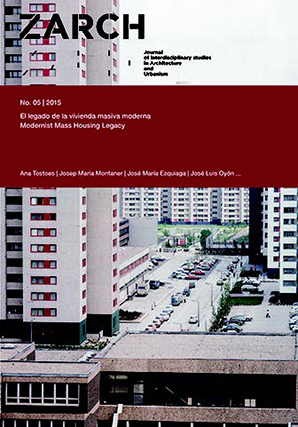Legacies of the South Korean Mass Housing
DOI:
https://doi.org/10.26754/ojs_zarch/zarch.201559104Palabras clave:
Mass housing in South Korea, developmental housing policy, diffusion of modernist models, urban renewalResumen
The mass housing policies of the South Korean developmental state during the second half of the 20th century managed to overturn the traditional preference for single-storey housing in less than one generation. The exponential growth of the GDP since 1961 occurred hand in hand with the consolidation of apartment complexes as the default element of city-making and as the default domestic setting. As a result, they today are the residential choice of more than 50% of the population of Seoul. Not only have housing estates addressed the chronic housing shortage present in the capital since the 1920s, but they have also been a key element in the fast urbanization of the country and in the formation of a new urban middle class. Nowadays, there are evidences that the socio-economic model which supported the emer- gence and generalization of mass housing estates in Seoul has changed, questioning the very durability of the model. The objectives of the article are twofold. Initially, it describes the particularities of the Korean mass housing policy, the reasons for its success despite being perceived as a failure in the West, and its shared characteristics with other East Asian developmental regimes. Secondly, it discusses its legacy, both in terms of the know-how that Korean construction companies are trying to export to developing countries, but also in terms of the consequences which the maintenance of this large built urban stock will hold in the near future.
Descargas
Referencias
"BAE, C.-H. C. (1998). “Korea’s Greenbelt’s: Impacts and Options for Change”. Pacific Rim Law & Policy Journal [Online] Volume 7, Pages 479-502. Available: https://digital.law.washington.edu/ dspacelaw/bitstream/handle/1773.1/867/7PacRimLPolyJ479.pdf?sequence=1 [Accessed June 20th, 2015]
CHANG, H.-J. (1999) “The Economic Theory of the Developmental State”. In: Woo-Cumings, M. (ed.) The Developmental State. Ithaca, NY, Cornell University Press. Pages 182-199.
DOLING, J. & RONALD, R. (2014) “The Changing Shape of the East Asian Housing Model”. In: Doling, J. & Ronald, R. (eds.), Housing in East Asia. Socioeconomic and Demographic Challenges. Basingstoke, Palgrave Macmillan. Pages 9-43.
DONG-A ILBO (2012) “Seoul Mayor Announces Exit Plan for ‘New Town’ Project” [Online]. Available: http://english.donga.com/srv/service.php3?biid=2012013123938 [Accessed June 15th 2015].
FERRER, A. (1996) Els polígons de Barcelona. L’habitatge massiu i la formació de l’àrea metropolitana. Barcelona, Edicions UPC.
GELEZÉAU, V. (2003) Séoul, ville géante, cités radieuses. Paris, CNRS Editions.
HAN, S., (1986) “Measuring the Social Cost of the Greenbelt Zoning”. In: Mills, E. (ed.) Korean Government Policies Towards Seoul’s Green Seoul, Korea Research Institute for Human Settlements.
HEIN, C. (2003) “The Transformation of Planning Ideas in Japan and its Colonies”. In: Nasr, J. & Volait, M., (eds.) Urbanism: Imported or Exported? 1st ed. Chichester, UK, Wiley-Academy. Pages 51-82.
HWANG, K. (2003) “Seoul’s Parks and Green Spaces in the 20th Century: From a City in Nature to Nature in the City”. In: Kim, K.-J. (ed.) Seoul, 20th Century – Growth and Change in the Last 100 Years. 1st ed. Seoul, Seoul Development Institute. Pages 365-431.
JENCKS, C. (2002) The New Paradigm in Architecture : the Language of Post-Modernism. New Haven, Yale University Press. KIM, K.-J. (2004) “Inner City Growth Management Problem in Seoul: Residential Rebuilding Boom and Planning Response”. In: Sorensen, A., Marcotullio, P. J. & Grant, J. (eds.), Towards Sustainable Cities. East Asian, North American and European Perspectives on Managing Urban Regions. Aldershot, UK, Ashgate Publishing Limited. Pages 267-283.
KOYAANISQATSI: LIFE OUT OF BALANCE (1982) Directed by Reggio, G., US, Island Alive, New Cinema [DVD]
KYUNG, S. (2011) “State-facilitated Gentrification in Seoul, South Korea: for Whom, by Whom and with What Result?”. International RC21 Conference: The Struggle to Belong. Dealing with Diversity in 21st Century Urban Settings. Session 2: Social Consequences of Gentrification. 7-9 July 2011, Amsterdam. Available at: http://www.rc21.org/conferences/amsterdam2011/edocs/Session%20 2/2-1-Kyung.pdf [Accessed June 15th, 2015].
LAND AND HOUSING CORPORATION (한국토지주택공사) (2010) 2010토지주택통계편람 (2010 Year Book of Land & Housing Statistics). Seoul, LH Corporation.
LAND AND HOUSING CORPORATION (한국토지주택공사) (2012) 해외 주요 진출대상국의 도시개발제도 조사 연구 (Research on Urban Development Policies of Foreign Target Countries). Seoul, LH Corporation.
MAEIL BUSINESS NEWSPAPER (2015) “Seoul City Cancels 28 New Town Projects” [Online]. Available: http://news.mk.co.kr/breakingnews/view.php?no=385421&year=2015& categorycode=MK400101 [Accessed June 20th, 2015]
PARK, J.-M. (2013) “Struggling Korean Builders Tell Employees to Show Loyalty: Buy Apartments”. In: Reuters [Online]. Available: http://in.reuters.com/article/2013/05/29/korea-economy-housingidINDEE94S0I520130529 [Accessed May 30th, 2015].
ROWE, P. G. (2005) East Asia Modern. Shaping the Contemporary City. London, Reaktion Books.
SEOUL DEVELOPMENT INSTITUTE (2005) “Housing and Construction”. In: Changing Profile of Seoul – Major Statistics and Trends. Seoul, SDI.
STOKOLS, A. (2014) “Songdo style: How wise is Korea’s ‘Smart City’?”. In: Korea JoongAng Daily [Online]. Available: http://koreajoongangdaily.joins.com/news/article/article.aspx?aid=2994022 [Accessed July 21st, 2015] YU, M. J. (2013) “New Town Developments In Korea: Then and Now”. In: Del Cerro Santamaría, G. (ed.) Urban Megaprojects: A Worldwide View. Bingley, UK, Emerald Group Publishing Limited. Pages 8-23."





